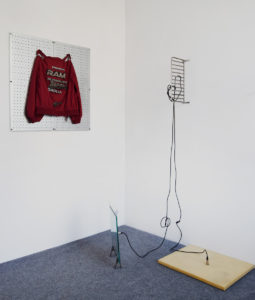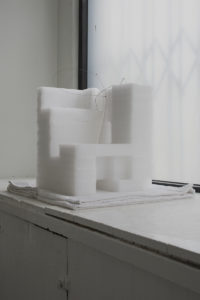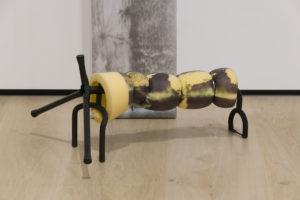“My research is never really linear,” writes Inglewood-based artist Nikita Gale. “I find myself irresistibly attracted to something, then I just get really curious and it finds its way into my work. That attraction is kind of like data to me.” The artist’s sprawling installation ‘PROPOSAL: SOFT SURROUND SYSTEM’ (2018) now on view as part of Made in L.A. 2018 at the Hammer Museum, gives the sense of an unrelenting data flow made material – in all of its repetitions, mutations, and aberrations.

What Gale accomplishes in this work, though, is far more nuanced than a visualization of information. The installation’s construction is rooted in a sense of provisionality and urgency, drawn from the artist’s investigation into the ad-hoc construction of barricades during moments of revolution and protest in 19th century France. ‘PROPOSAL,’ in its rhythmic tangle of mic stands, cables, towels, foam baffling and curb rubbings, at once chaotic and formally ordered, reflects this threshold state. Extending the logic of the barricade in moments of political and social upheaval, from the 1992 LA uprisings to current moment, ‘PROPOSAL’ asks us to consider how we too might be in need of models for such protective structures.
Before developing a visual practice, Gale was a self-described “bedroom musician,” and studied anthropology and archaeology, disciplines that necessitate looking closely at artefacts for evidence of their use, as well as of the cultural forces that shaped the conditions of their making. Her earlier sculptures and installations synthesize and extrapolate on the politics of materials, calling upon the personal and cultural histories latent in the objects she includes in them.
Making use of items with embedded cultural significance and prosthetic function, like cars and electric guitars, as well as of objects with bodily associations, she builds a precise tension that corrupts a one-to-one translation between a thing and its meaning within the context of her art. Gale’s attunement to the possibilities of objects, as both raw material and metaphor, leaves welcome space for ambiguity and affect, which are too often absent in research-based artistic practices.
First meeting for café con leche and a leisurely Sunday stroll, Gale and I began a conversation about her work and continued writing to each other in the weeks that followed.

**You’ve spoken before about your obsession with objects and taxonomies of objects. Is it the thing-ness of objects that interests you, or the sense of how things relate to human subjects?
Nikita Gale: It’s both! I’m interested in a feedback loop that I perceive between the human ability to manipulate materials in the environment to fulfill needs and desires and the way that this fulfillment might create opportunities for unanticipated effects or influences on subjectivity.
When I was at UCLA for my MFA in New Genres, I worked with the Neolithic stone tool collection at the Fowler Museum for a video I produced that was part of my graduate thesis show. Because the artefacts are stone, I was allowed to handle them myself without gloves. The most surprising thing to me about that experience of working with the Neolithic collection was how attuned the object was to my hand – the scale, the weight, the shape – all of these elements made the objects feel like a real extension of my body which is really the function of any technology. I highly recommend holding an ancient tool if you ever get a chance, it’s pretty wild.
**I love the idea of handling Neolithic stone tools! As an undergrad at Yale, you studied archaeology and later anthropology. How do you feel these disciplines inform your artistic process?
NG: Both archaeology and anthropology have pretty fraught histories particularly in relation to colonialism, so this is something I’m always dealing with when I do find myself employing these methodologies, however abstractly. The point I find myself most frequently circling around is the way in which historical documentation is just a collection of subjective experiences that have been cited and repeated frequently enough to be broadly accepted as given facts.
While there are certainly a number of ways that a discipline like archaeology might attempt to rule out the subjectivity of the archaeologist in the determination of the function of an artefact (carbon-dating to determine relative age of an artefact, for example), it can be pretty speculative, and that was something that I held on to and carried over into my practice. The way I’m saying this makes it sound more calculated and thoughtful than it really is! I like thinking about how at a certain time there were hundreds maybe thousands of people who all knew what something was and now it has gradually become a mystery. It’s almost as if there’s an element of coping with abstraction that comes into play, which is where my recent work might come into the picture. I’m interested pushing contemporary objects forward into that abstraction.

**You kind of do that with foam and towels in ‘BIG BAD PICKUP’ and ‘PROPOSAL: SOFT SURROUND SYSTEM.’ How are you thinking about these soft materials?
NG: Towels are responsive to physical qualities of human bodies. They are soft and flexible. They drape. They absorb. They are also kind of abject. I first started using towels in my work a little over a year ago with ‘BIG BAD PICKUP’ which you saw at The Studio Museum in Harlem last fall. They came up because in the rabbit hole of internet research I’d been doing about DIY noise cancellation and sound baffling, I was finding all of these tutorials about using bath towels as sound panels for home recording studios.
I was also reading Michel Chion’s Sound: An Acoulogical Treatise and was just really deeply invested in thinking about access to materials and how a person might find ways to produce a desired effect of silence or noise baffling in spite of material conditions that might make achieving that effect more difficult.
**Conditions like?
NG: Like the average noise level of the neighborhood you live in and income [of its inhabitants] which are all functions on some level of gender, race, and class. This type of making became a perfect analog for barricade construction which is why I’m now having this moment in my studio where these things are coalescing in a really cool way.
**In these same works, you’re using materials that conduct, produce, and amplify sound as well as the muffling foam and towels. What’s the logic behind this seeming want to simultaneously cancel out?
NG: I’d say that I am working in a way that allows the materials to function as an analog for what I’ve been experiencing on a personal and psychic level. The condition of simultaneously making noise or desiring to make noise but also wanting to feel some level of safety or protection is something that is intensified the further away an individual might find themselves from access and agency.
I’m using music and, more broadly, sound production, as a framework to explore this condition. The materials involved in the production and disruption of sound operate as a really nice analog with these concepts. To be clear, I’m not at all thinking of the materials as symbolizing a specific idea or concept in a direct one to one analog; it’s more about attitude, affect, and effect for me.

It’s also important to me that the objects can be recognized for what they are because that puts them in this funny position of referencing their original context while inhabiting a totally different space of abstraction in this kind of sculptural, conceptual system I’m placing them in with my work. So while I am thinking of artists like Jason Rhoades, Noah Purifoy, and Cady Noland when I’m considering my own relationship to this kind of art making, I’m more so thinking about traditions of southern yard art, or playing house with my cousins in Georgia and hiding out in one of the hundreds of cars my grandfather had on his property, or as I’ve mentioned earlier, early barricade and blockade construction.
**You’ve dealt with car culture and rock music in your work. If I had to gender the public perception/discourse around these two phenomena I’d say that it skews towards the masculine, but your treatment of these subjects works against that. Does your interest in them come from an intentional desire to push at this?
NG: I’m a subject of capitalism which means I’m susceptible to messaging and biases that I experience in the types of media and culture that I consume, and sometimes I can still absorb messaging and imagery that maybe isn’t intended for my “demographic”. Anything in my process or approach that might seem to be pushing at this masculine character might simply be because I’m approaching it from a purely subjective place that makes sense to me but throws off a larger cultural narrative around cultures of cars and guitars and rock music. I also think that queerness complicates this position in the sense that I could be perceived as both occupying and desiring the same identity, biologically maybe, but this shifts dramatically if you consider the profound level of nuance operating within the spectrum of femme/female gender presentation.
**Could you talk a little bit about your recent research into histories of protest and the form of the barricade that ‘PROPOSAL’ dealt with?
NG: Some top line subjects I was focusing on with the Made in LA work were:
– Oppressed groups finding alternative modes of expression (music).
– Taking objects and turning them into raw materials for some other kind of system.
– DIY ingenuity that is only borne out of a matrix of lack of access, urgency, irreverence, tenacity.
In the research I was doing about barricades, the thing that stood out to me the most profoundly was the kind of attitude of the working class in their constructions of the barricades in 19th century France. Some keywords I might use to describe the nature of barricade construction might be: urgency, ingenuity, safety, encryption. The idea of people literally pulling up pieces of the street, taking personal belongings, garbage, whatever they could get their hands on, to block off access and to protect their environment was a really profound concept.
**And then you relate this to other moments of upheaval?
NG: As an American citizen who identifies as female, Black, and lesbian, I have a number of inheritances that I’m finding myself coming to terms with on a personal and professional level as an artist. I’m inheriting strategies and methodologies of dealing with materials and coping with my surroundings. I’d say that for me, the term “research” is a broad term that encompasses a lot of different modes of learning and acquiring information. This process is embodied and experiential as much as it is reading and watching films and going to music shows; it also requires reflection and consideration of my surroundings.

I live in Inglewood, California just a few blocks from Florence and Normandie which is where the 1992 Rebellion in South LA started. I was thinking about this space and I was looking at videos and thinking about how all of these images were looking a lot like a proposal to me. I was seeing what had happened but also that this thing that happened had been possible.
For a few days in Los Angeles, a space had been created where you basically weren’t safe if you weren’t Black and all of the cops disappeared. That’s some pretty wild shit and it happened because language stopped working. People didn’t feel heard, there was bewilderment, and in a really profound way this was an event that really seemed like it was targeting the toxic infrastructures of capitalism by actually destroying property. When it happened, the LA rebellion was the fifth most expensive disaster in history for insurance companies in U.S.
**You’ve talked about the research that underpins your work through the notion of ‘data’, as well as in terms of personal connections to the material likening your process both to note taking and essay writing. How do these language-based methods coalesce for you into work that’s really quite formal?
NG: I started out as a bedroom musician and then worked as a music photographer for a few years before developing what is now more of a visual art studio practice. I’ve been listening to a lot of PJ Harvey, Sister Rosetta Tharpe, St. Vincent (always), and Anna Calvi recently. Listening to them really makes me think about the song as a kind of temporal container that frames these mesmerizing, chaotic, virtuosic, controlled performances. Also experiencing their work is a reassuring reminder that politics and spirituality always have a kind of erotic potential. I think a lot about music when I’m working. I believe that work can be formal and sexy and seem chaotic but ordered in some way. **
Nikita Gale’s ‘PROPOSAL: SOFT SURROUND SYSTEM’ can be seen at Made in LA 2018 at the Hammer Museum through September 2, 2018. Look out for her work in forthcoming group exhibition Relics at Paris’ Ceysson & Bénétière, running from September 6 – October 13, 2018, and an upcoming solo show at Los Angeles’ Commonwealth and Council running September 22 – November 3, 2018.













